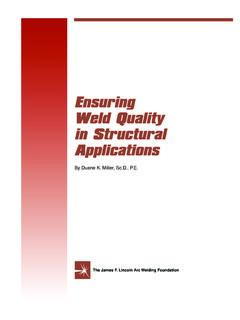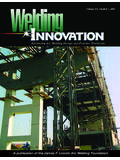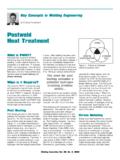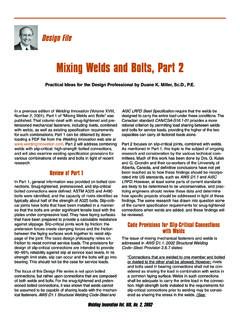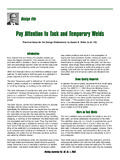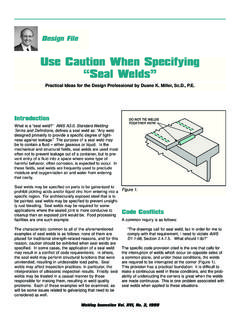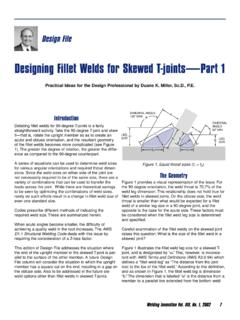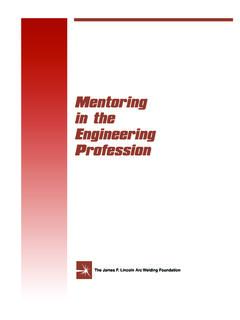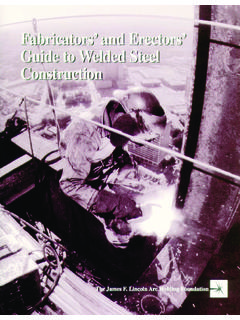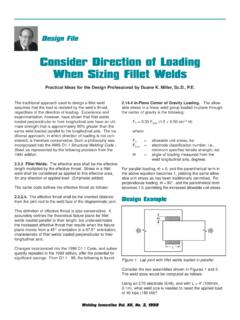Transcription of The Challenge of Welding Jumbo Shapes - Foundation
1 The Challenge of WeldingJumbo ShapesReprinted Articles from Welding Innovation MagazineThe James F. lincoln Arc Welding Foundationby Omer W. Blodgett, , and Duane K. Miller, , Innovation Vol. X, No. 1, 1993 Australia and New ZealandRaymond K. RyanPhone: 61-29-772-7222 Fax: 61-29-792-1387 CroatiaProf. Dr. Slobodan KraljPhone: 385-1-6168306 Fax: 385-1-6157124 HungaryDr. G za Gremsperger Phone: 361-156-3306 IndiaDr. KrishnanPhone: 91-11-247-5139 Fax: 91-124-321985 JapanDr. Motoomi OgataPhone: 81-565-48-8121 Fax: 81-565-48-0030 People s Republic of ChinaDai Shu HuaPhone: 022-831-4170 Fax: 022-831-4179 RussiaDr. Vladimir P. YatsenkoPhone: 07-095-238-5543 Fax: 07-095-238-6934 United KingdomDr. Ralph YeoPhone & Fax:44-1709-3799053 Part I: The AISC Specifications6 Part II: Increasing Ductility of Connections10 Part III: Case Study12 Consider Welded Vs. Bolted Connections for Jumbo SectionsThe serviceability of a prod-uct or structure utilizing thetype of information presentedherein is, and must be, thesole responsibility of thebuilder/user.
2 Many variablesbeyond the control of TheJames F. lincoln Arc WeldingFoundation or The LincolnElectric Company affect theresults obtained in applyingthis type of variables include, butare not limited to, weldingprocedure, plate chemistryand temperature, weldmentdesign, fabrication methods,and service ASSISTANT SECRETARIESV olume XNumber 1, 1993 EditorDuane K. Miller, , EditorR. Scott FunderburkThe James F. lincoln Arc Welding FoundationOmer W. Blodgett, , ConsultantThe Challenge of Welding Jumbo ShapesVisitWelding Innovationonline at Welding Innovation Vol. X, No. 1, 1993 The Challenge of Welding Jumbo ShapesPart I: The AISC SpecificationsBy Duane K. Miller, Design EngineerThe lincoln electric Company, Cleveland OhioIntroductionIn 1989, the American Institute of SteelConstruction developed specifications forwelding Jumbo Shapes . The next three arti-cles will review the AISC specifications, dis-cuss additional Welding engineering principlesand structural details that will contribute to thesuccess of similar projects, and present acase study of a recent successful projectwhich utilized these principles Problems ofWelding Jumbo ShapesDuring fabrication and erection of weldedassemblies that utilized Group 4 and 5shapes, commonly called Jumbo sections, cracking problems were experienced on anumber of projects.
3 Particularly alarmingwere complete, through-section cracks thatoccurred in the tension cords of large truss-es. The failures were classic brittle-type frac-tures that occurred in the complete absenceof service loads. The typical crack wouldbegin in the region of the weld access holeand propagate through the web, or theflange, or both. The fracture was usually inthe base metal, with the weld , since these incidents occurredduring construction, their impact was mini-mized. Nevertheless, these experiencescaused many engineers to look to alternatematerials or revert to bolted connectionswhen Jumbo Shapes were 4 and 5 Shapes are very heavy rolledsections that weigh up to 848 pounds per lin-ear foot (see Figure 1). During the initialsolidification of the ingot used to make theseshapes, it is possible for carbon and otheralloys to segregate, causing an enriched con-centration of elements in the center of theingot. Upon rolling, the outer surfaces of theshape being formed will be cooled by the millrolls and other external cooling methods.
4 Inaddition, the surfaces of the shape receivesignificant mechanical working, improving thetoughness of these surfaces, but the centerregion receives minimum mechanical work-ing. As shown in Figure 2, a cast structureis formed in the middle of the section whichmay exhibit poor notch toughness. Wherefailures have been experienced in the past,poor toughness in this region has been greatest problems with Welding on jumboshapes occurred when these materials, origi-nally contemplated for compression (or col-umn) applications, were used in tensionapplications. Since the failures occurredbefore the structures were subject to serviceloads, the difference was not inherent to theapplication, but rather to the type of welddetails used in the two types of primary tensile applications, CompleteJoint Penetration (CJP) groove welds typical-ly are required. For compression applica-tions, Partial Joint Penetration (PJP) groovewelds generally are sufficient.
5 When CJPgroove welds are used, weld access holes(colloquially known as rat holes ) arerequired. For PJP groove welds, they arenot. The presence or absence of weldaccess holes, and the difference in residualstresses experienced by CJP welds (whichhave greater weld metal volume than PJPgroove welds) explain the difference inbehavior between tension and compressionapplications. The PJP groove weld may notintersect the as-cast core structure in thecenter of the section, while the weld accesshole used with CJPs automatically intrudesinto this common method of preparing the variousrolled sections for Welding is to use the oxyfuel thermal cutting process, which generatesa change in microstructure. The surface maybe enriched in carbon content, and the hotsteel on the surface of the cut is rapidlycooled by the conduction of heat into the sur-rounding steel. As a result, a small, thinlayer of relatively hard, brittle microstructuremay form. Under some conditions, micro-cracks have resulted in this zone.
6 Goodworkmanship is also required in this area. Insome cases, ragged edges resulted in crack-like notches in the weld access hole complicating the cutting process isthe semicircular nature of the weld accesshole, where good manual dexterity isrequired in order to create a uniform , as the cut approaches the region ofthe web-to-flange interface, the natural radiusthat occurs in rolled Shapes makes precisecutting difficult. In many examples involvingfracture, poor workmanship resulted in inade-quate preparation of the weld access welds cool from elevated tempera-tures, they must shrink in size due to thethermal contraction that takes 1. Group 4 and 5 Shapes can weighup to 848 pounds per linear 2. A cast structure is found in themiddle of the Innovation Vol. X, No. 1, 19934As the hot, but already solidified, weld metalshrinks in size, it induces shrinkage strainson the surrounding materials. These strainsinduce stresses that cause localized the weld metal cools to near-room tem-perature, the remaining strain may be insuffi-cient to cause yielding, but will result inresidual stresses that are present after weld -ing is complete.
7 For example, a weld that isused to join flanges will establish a residualstress pattern that is transverse and longitu-dinal to the direction of Welding . The webweld will similarly set up a longitudinal andtransverse shrinkage stress. Surrounding theregions of high residual tensile stress, therewill be a region of residual compressivestress. When weld access holes are small insize, the residual stresses from these twowelds can combine and develop into a triaxi-al state of stress. Under these conditions,the steel may be unable to exhibit its normalductility, although the same material underuniaxial conditions may behave in a veryductile fashion. The formation of this high tri-axial stress in the region of the web-to-flangeinterface is the driving force behind the initia-tion of these brittle 3 illustrates the interaction of weldtype (CJP vs. PJP), weld access holes, andthe cast core region. In the top figures, theCJP preparation automatically intersects theregion of the shape with questionablemicrostructure.
8 For the PJP, the absence ofaccess holes, plus the reduced depth ofbevel, minimizes or eliminates the amount ofcore region that is intersected by the cuttingprocess. As a result, weld metal, and theshrinkage stress it will induce, does notdirectly act on the core mechanics methods may be used todetermine the required notch toughness toprevent brittle fracture. In the case of thejumbo section failures, the cracks located inthe weld access holes were of sufficient size,and the residual stresses from Welding of asufficient level, that they exceeded the resist-ing force, or the fracture toughness, of thebase material, particularly in the cast coreregion. To ensure reliable fabrication, theAISC Task Group addressed all three issues:notch toughness of the base material, qualityof the weld access holes, and a reduction inthe residual stresses developed by examin-ing the geometry of the weld access AISC ResponseThe AISC task group set up to study thismatter established, and the SpecificationCommittee adopted, a series of controls topermit problem-free Welding of Jumbo sec-tions.
9 These were initially published in 1989as Supplements 1 and 2 to the AISC SteelConstruction Manual. They have now beenincorporated into the ninth edition of the ASDM anual. The first was a requirement that thebase metal exhibit a minimum notch tough-ness of 20 foot-pounds at +70 F. It isrequired that the Charpy specimens be takenfrom the web-to-flange interface, the regionexpected to have the poorest toughness. Avariety of methods may be employed toimprove the notch toughness in this area,including the use of semi-killed steel, fine-grain practice, and special cooling provide additional resistance to crackingduring the thermal cutting of weld accessholes, the specification now requires a pre-heat of 150 F before the thermal cutting is tobe performed. This slows the cooling rateexperienced by the cut surface, providingincreased resistance to cracking . After ther-mal cutting, the surfaces must be ground tobright metal and inspected with either mag-netic particle testing (MT) or liquid penetranttesting (PT), further assuring smooth transi-tions that are free of notches and order to reduce the level of residual stress-es in the area of concern, specific minimumdimensional requirements were imposed onthe size and shape of the weld access minimum size for the width of the weldaccess hole is required to be times thethickness of the web on either side of thejoint.
10 The root opening and overall width ofthe weld joint further add to the width of theaccess hole, as shown in Figure 4. If a B-U2-S type prequalified Welding joint is usedon a W 14 x 730 rolled section, the resultingtotal weld access hole dimension is requiredto be a minimum of inches. These mini-mum dimensions are required for severalreasons. First, generously sized weldaccess holes prohibit the residual stress pat-terns from the flange welds and the webweld from interacting with each other. Whenthe radius which forms the end of the weldaccess hole is placed away; from the flangeweld, the radius is located in a region ofresidual compressive stress, or a region ofnearly no either case, ductility ofthe steel is enhanced. Finally, the separationof the web from the flange for this distancepermits the unrestricted yielding of the webregion. When small access holes are used,the web, rigidly attached to the flanges, isforced to absorb all the shrinkage stresses ina very small area, concentrating stressesright in the region of concern: the weldaccess hole.
